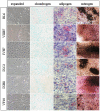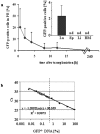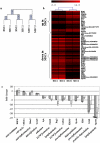Radiation rescue: mesenchymal stromal cells protect from lethal irradiation
- PMID: 21245929
- PMCID: PMC3016319
- DOI: 10.1371/journal.pone.0014486
Radiation rescue: mesenchymal stromal cells protect from lethal irradiation
Abstract
Background: Successful treatment of acute radiation syndromes relies on immediate supportive care. In patients with limited hematopoietic recovery potential, hematopoietic stem cell (HSC) transplantation is the only curative treatment option. Because of time consuming donor search and uncertain outcome we propose MSC treatment as an alternative treatment for severely radiation-affected individuals.
Methods and findings: Mouse mesenchymal stromal cells (mMSCs) were expanded from bone marrow, retrovirally labeled with eGFP (bulk cultures) and cloned. Bulk and five selected clonal mMSCs populations were characterized in vitro for their multilineage differentiation potential and phenotype showing no contamination with hematopoietic cells. Lethally irradiated recipients were i.v. transplanted with bulk or clonal mMSCs. We found a long-term survival of recipients with fast hematopoietic recovery after the transplantation of MSCs exclusively without support by HSCs. Quantitative PCR based chimerism analysis detected eGFP-positive donor cells in peripheral blood immediately after injection and in lungs within 24 hours. However, no donor cells in any investigated tissue remained long-term. Despite the rapidly disappearing donor cells, microarray and quantitative RT-PCR gene expression analysis in the bone marrow of MSC-transplanted animals displayed enhanced regenerative features characterized by (i) decreased proinflammatory, ECM formation and adhesion properties and (ii) boosted anti-inflammation, detoxification, cell cycle and anti-oxidative stress control as compared to HSC-transplanted animals.
Conclusions: Our data revealed that systemically administered MSCs provoke a protective mechanism counteracting the inflammatory events and also supporting detoxification and stress management after radiation exposure. Further our results suggest that MSCs, their release of trophic factors and their HSC-niche modulating activity rescue endogenous hematopoiesis thereby serving as fast and effective first-line treatment to combat radiation-induced hematopoietic failure.
Conflict of interest statement
Figures







References
-
- Fliedner TM, Friesecke I, Beyrer K. Medical Management of Radiation Accidents: Manual on the Acute Radiation Syndrome. Oxford: British Institute of Radiology; 2001. - PubMed
-
- Drouet M, Hérodin F. Radiation victim management and the haematologist in the future: time to revisit therapeutic guidelines? Int J Radiat Biol. 2010;86:636–648. - PubMed
-
- Hérodin F, Drouet M. Cytokine-based treatment of accidentally irradiated victims and new approaches. Exp Hematol. 2005;33:1071–1080. - PubMed
-
- Chao NJ. Accidental or intentional exposure to ionizing radiation: biodosimetry and treatment options. Exp Hematol. 2007;35:24–27. - PubMed
Publication types
MeSH terms
LinkOut - more resources
Full Text Sources
Other Literature Sources
Molecular Biology Databases

